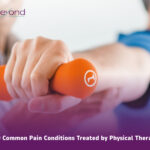What does it mean when someone says they have an autoimmune disorder? It is when your immune system starts attacking your own cells. Thinking your own cells are foreign invaders. When they are not. Your body may attack cells in your muscles, joints, nerves, digestive tract, 0r endocrine organs. All of which are influenced by stress, genetics, the environment, as well as hormone changes. Your body may experience an autoimmune response due to these various stimuli. Unfortunately, autoimmune issues are on the rise, and have become more and more common. Pain is often accompanied with these disorders. And often manifests in multiple areas of the body. Therefore, in order to heal autoimmune pain, it takes a multifaceted approach.
Integrative Healing
Pain caused by an autoimmune diagnosis. Is not usually caused by an accident, fall or other injury. The trajectory of healing is different. As the source of pain isn’t always as straight forward as a single joint, tendon or ligament. The source of pain can involve more than one joint in the body, one or more organ structures, the nervous system, connective tissues, etc. Therefore, a whole body approach is essential.
Fight of Flight
A cascade of events may occur when stress is present. Understanding the whole body is involved when an autoimmune response occurs is important. The fight or flight response is on repeat if not properly checked. This response is important when first injured. But, when the on button cannot be turned off. It can wreak havoc. And as it continues to send stress signals, a cascade of hormones, neurotransmitters and other responses throughout the body. Your cells continue attacking each other and can result in a wide variety of symptoms. Some include joint and muscle pain, headaches, fatigue, brain fog, digestive upset, etc. It depends on which areas of your body are more vulnerable to these reactions.
Environmental Factors
Internal Environment
Autoimmune symptoms can come in waves. In these situations, your body is on constant defense as your own cells are attacking themselves. Creating inflammation throughout the body. You can change your body’s internal response. This is one step in healing your autoimmune pain. If you are able to incorporate high quality food, nutrients, exercise, and sleep. Pain and inflammation can start to decrease naturally. While reducing the inflammatory intake of processed foods, vaping, cigarettes, sodas, sugar, and alcohol. All of which make your body work harder, contributing to an inflamed internal environment.
Your body’s inner landscape, also known as the microbiome, is made up of billions of cells, bacteria, viruses, fungi, and parasites. They live in your lungs, gut, skin and reproductive organs. Depending on where these cells are damaged within your body. This imbalance can affect how many of your organs function. What you put into your body will positively or negatively affect this internal landscape. The intensity and frequency of joint pain, numbness and tingling, stomach aches, headaches, brain fog, fatigue, weakness, etc. Can improve based on what you put into your body’s internal environment.
External Environment
Understand that your external environment also plays a key role in how you feel. Whether you have been exposed to mold, live near a high EMF cell phone tower, live and work in a smoggy, busy, noisy city. Or find yourself on your phone into the evening hours when you should be going to sleep. The blue light from your own personal cell phone may affect your circadian rhythms, diminishing sleep affecting your overall ability to heal. If you experience one or all of these factors, ones health may be compromised. And can magnify the autoimmune symptoms you may be experiencing.
Addressing both internal and external environments is essential when understanding how to heal autoimmune pain.
Common Autoimmune Disorders
Some of the more common autoimmune symptoms that may bring you to see an integrative Physical Therapist include: Osteoarthritis, Rheumatoid Arthritis, Fibromyalgia, Multiple Sclerosis, Diabetes and Celiac disease to name a few. All of which may result in joint stiffness or abnormalities, muscle pain, myofascia discomfort, weakness, neuropathy, digestive imbalance, fall risk and fatigue.
All of these incorporate multiple areas of the body. They are not straight forward musculoskeletal issues like traditional injuries sustained from a fall, car accident, sporting injury, etc. Often times, depending on weather, internal or external stress, sleep and the like. Symptoms can wax and wane.
How to Heal Autoimmune Pain
Whole Body Physical Therapy
Whole body physical therapy helps restore and reset your nervous system, can improve digestion and circulation. This type of therapy may also build strength, stability and endurance of your muscles, tendons and ligaments.
Improving the health of the neuromuscular and musculoskeletal systems is imperative. These systems build strength, stability, and body awareness. Your digestive system also provides a key role in healing autoimmune pain. Pain receptors not only exist in your skin, muscles and joints. They also exist in your digestive tract. The gut plays a much larger role in improving autoimmune symptoms, including pain. One of the many reasons why holistic physical therapy that incorporates visceral, craniosacral and integrative manual therapy can help your symptoms. As it helps reduce scar tissue, allows your fascia to unwind gently, while decreasing flare ups. A cascade of increased blood flow, improving lymph drainage, releasing nerve tension and fascia restrictions.
A Multi-faceted Approach
When it comes to healing long term issues, it is not about, no pain no gain. There are many ways to reduce pain through integrative physical therapy, nutrition, mindfulness and more. Improving autoimmune symptoms take time and dedication. Regular self care will provide a more long lasting effect. Without the side effects of medication. Naturally decreasing inflammation and stress. Can reduce pain and provide a sense of well being.
Take Away
If autoimmune symptoms are a part of your day to day life. Improving your quality of life is very possible. How you take care of yourself on a daily basis is very important. Feeding your body from the outside in with integrative physical therapy and gentle exercise. While simultaneously healing from the inside out with proper food, nutrients and sleep. Pain reduction may occur. Sleep can improve. Energy and mood are boosted. With time, you will be more in-tune with your body. Improving awareness, reducing stress, bringing you a new lease on life.
















